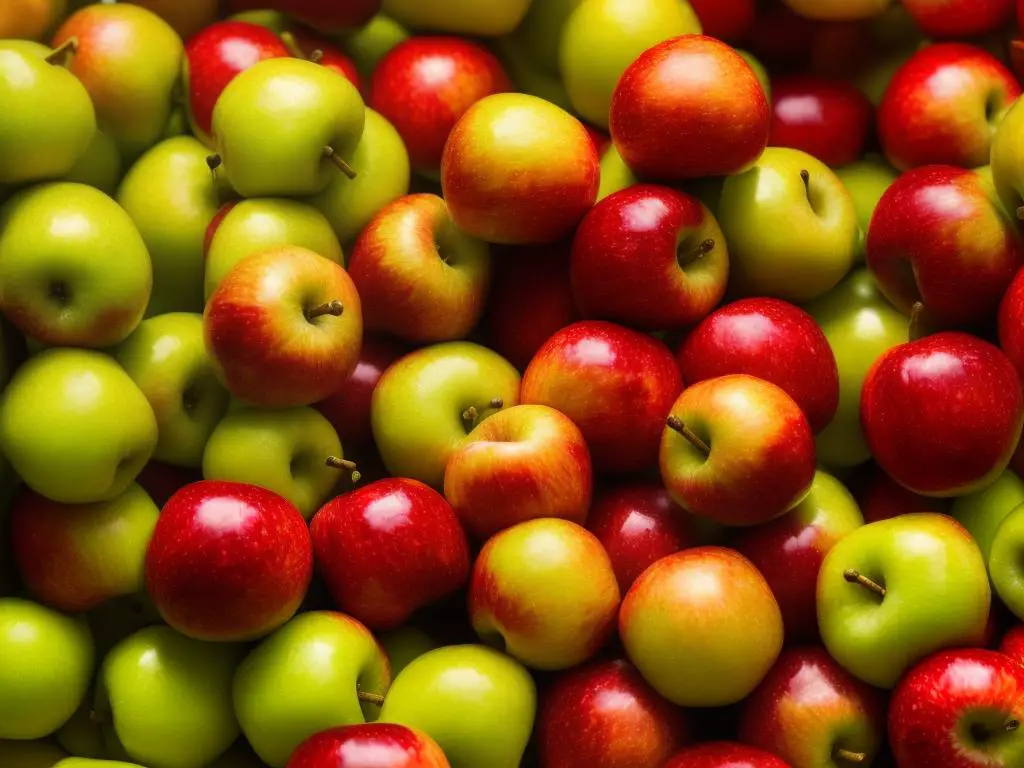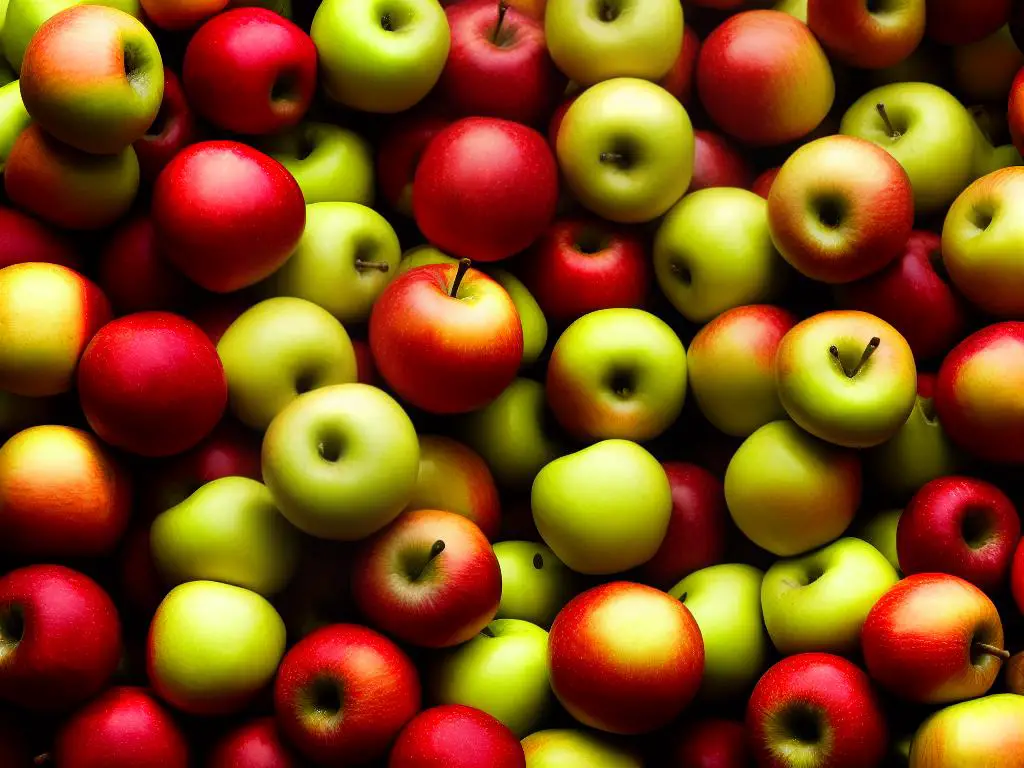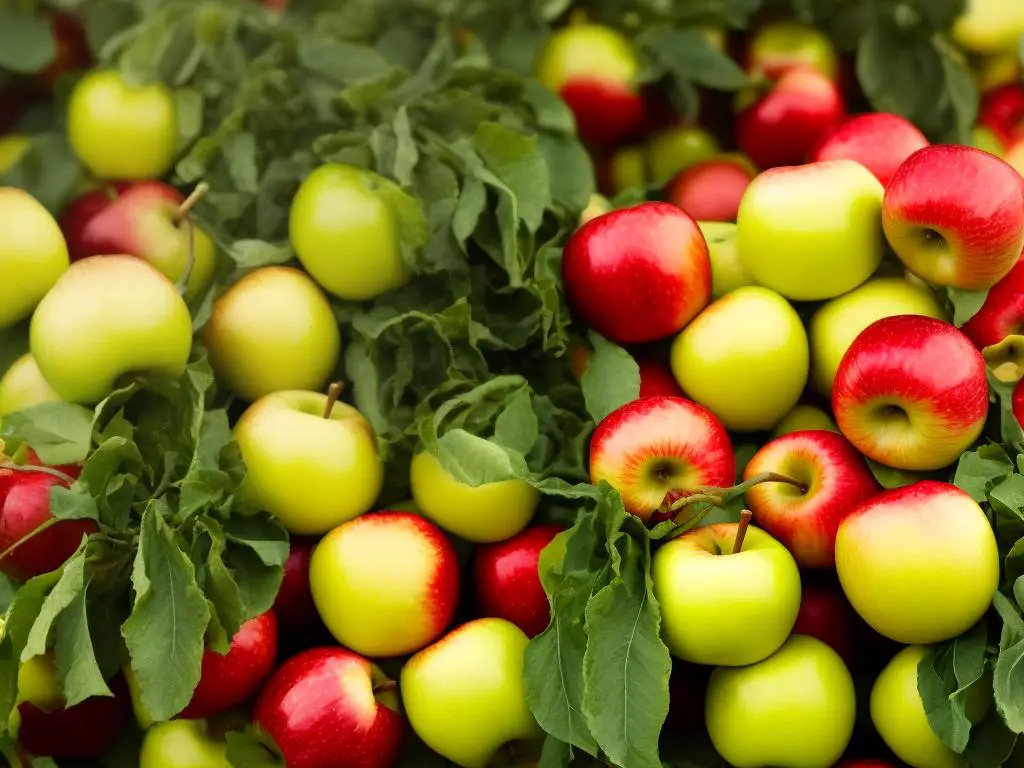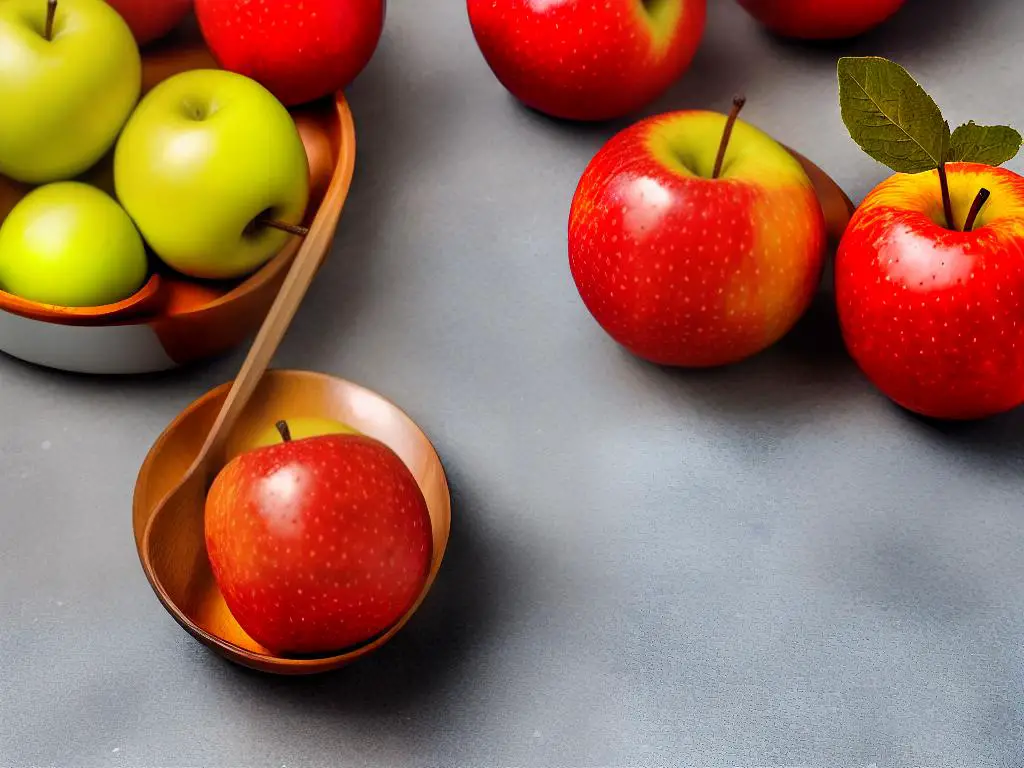Imagine sinking your teeth into a perfectly crisp, tantalizingly tart, yet delectably sweet apple: that’s the robust flavor experience offered by Jazz apples. Originating from the beautiful orchards of New Zealand, this vivacious fruit is more than just an apple – it’s a culmination of careful breeding, love for horticulture, and a dedication to promoting good health. This essay takes a detailed look at the fascinating history of Jazz apples, explores the cultivation and harvesting methods that ensure their exceptional quality, delves into the numerous health benefits and nutritional values they boast, and shares mouth-watering recipes and uses that highlight this variety’s unique flavor profile.
History and Origin of Jazz Apples
The Genesis of Jazz Apples
Jazz apples are a unique breed of apple that originated in New Zealand. Their creation was borne out of a desire to blend the sweet and tart flavors of the popular Royal Gala and Braeburn apples. The Jazz apple was developed by Plant & Food Research, a research institute based in New Zealand, and it is now grown under license in many parts of the world.
The story began in the 1980s when breeders started cross-pollinating the Royal Gala and Braeburn varieties in the hope of creating an apple that would combine the best features of both. After years of careful selection and cultivation, the Jazz apple was born. This apple variety is characterized by its attractive, blush-red skin, compact size, and a unique balance of sweetness and tartness.
Cultivation and Expansion
The Jazz apple was introduced to the public in New Zealand in 2004. It was first grown in the sunny regions of Hawke’s Bay and Nelson, places renowned for their ideal orchard conditions. The apple was named “Jazz” because of its bold, lively flavor which reminded tasters of the exuberance of jazz music.
Since its launch, the Jazz apple has garnered significant popularity due to its distinctive sweet-tart flavor, its firm and juicy texture, and its long shelf life. The apple’s appeal reached far beyond New Zealand, and it was soon being cultivated under license in many other parts of the world including Australia, the USA, the UK, France, Chile, and South Africa.
The Global Success of Jazz Apples
Since their introduction, Jazz apples have made a significant impact on the global apple market. The apples are now sold in over 60 countries and are enjoyed by consumers of all ages. Each Jazz apple is rated for its quality, crunch, and flavor before it is packed and shipped.
Year on year, Jazz apples have continued to grow in popularity and are often a top-performing variety in taste tests. Skilled growers across the globe continue to cultivate this high-quality variety, bringing the unique taste and characteristics of Jazz apples to more consumers every day.
Jazz Apples are not just enjoyed fresh. Their sweet-tart flavor and firm texture also make them excellent for cooking and baking. They retain their shape when cooked, making them a favorite choice for pies, tarts, and other baked goods.
Originating from a unique cross-breeding experiment in New Zealand, Jazz Apples have journeyed far. The fusion of the Royal Gala’s sugary palate and the Braeburn’s tangy flavor strikes a harmonious chord, offering a distinctive tasting experience in each mouthful. Indeed, they enjoy an impressive reputation in the apple world.

Cultivation and Harvesting Methods
Digging Deeper into Jazz Apples: Cultivation and Harvesting Techniques
Beholding the scientific name, Malus domestica, Jazz apples are a hybrid of Royal Gala and Braeburn varieties, first sprouted in New Zealand in the 1980s. They are prized for their unique taste and an exceptional aroma that clearly distinguishes them from other varieties. Their sturdy texture makes them highly versatile, holding up well whether employed in culinary dishes or baked items.
Footholds of Cultivation
Jazz apples are ideally suited to temperate climates, and thus, they are primarily cultivated in New Zealand, France, United Kingdom, Washington State in the US, and Chile. Although origin in New Zealand, today, Washington state produces the majority of Jazz apples sold in the U.S.
Growing Conditions
Due to the unique parentage of the Jazz apple, this variety thrives in slightly warmer climates than many apple varieties. The tree requires sufficient sunlight and a well-drained, fertile soil. While the tree can tolerate light frost, consistent temperatures below freezing can be detrimental to the crop. Also, Jazz apples require a bit more attention than other apple varieties. They need frequent and meticulous pruning to ensure productivity and maintain a balanced canopy.
Maturity Indicators for Harvest
To determine the perfect timing for their harvest, growers look for certain signs of maturity in Jazz apples. Mature Jazz apples tend to be of medium size with a rich, pinkish-red blush over a yellow-green base skin. They should be firm to the touch and have a sweet-tart taste. The apples’ lenticels (tiny specks on the skin) often open up and become more visible closer to harvest time, which can also be a good visual clue.
Harvesting and Yield
Harvesting of Jazz apples usually begins in late October and can run through November, depending on the weather. The apples are harvested by hand to prevent any bruising or damage. The exact time can depend on the region, climate, and individual growing conditions.
In terms of yield, the Jazz apples’ tree is a prolific bearer. It yields abundantly under the right growing conditions, which results in a high production rate. However, due the intensive care needed for this variety, the yield can be lower compared to other more resilient apple varieties.
Storage Post-Harvest
Jazz apples can be stored for up to 3 months at home, under the right conditions, as they are known for their long shelf life. For increased longevity, they can be stored in commercial conditions, where they can last up to a year. They maintain their taste, crunch, and nutritional value during this time, making them a preferred choice for out-of-season consumption.
Through the meticulous process of cultivation and harvesting, Jazz apples have come to be known for their consistently high quality and distinctive flavor, earning them a favored spot among apple enthusiasts worldwide.

Health Benefits and Nutritional Value
Understanding the Nutritional Value and Health Benefits of Jazz Apples
Born out of a hybridization between Royal Gala and Braeburn varieties, Jazz apples were first grown in New Zealand but have since been propagated across numerous countries, including the United States. Their unique blend of sweet and tart flavors coupled with numerous health benefits have contributed to their growing popularity.
Abundant in nutritional value, Jazz apples offer an array of health-boosting benefits. A medium-sized Jazz apple, weighing roughly 154 grams, delivers approximately 80 calories, no fat, and a healthy four grams of dietary fiber, which can promote good digestive health, lower the risk of heart disease, and assist weight control by creating a feeling of satiety.
Besides, Jazz apples serve as a significant source of Vitamin C, responsible for about 8% of the daily recommended intake. As a powerful antioxidant, Vitamin C can help strengthen the immune system, promote skin health via collagen production, and improve cardiovascular health by neutralizing harmful free radicals.
On top of that, Jazz apples also offer small quantities of Vitamin A, calcium, and iron, contributing to your well-rounded health. While Vitamin A supports eye health, calcium is essential for strong bones, and iron is important for maintaining energy levels and healthy blood.
Jazz apples’ skin isn’t just for show – it’s rich in dietary flavonoids known for their anti-inflammatory properties, disease prevention, and heart health support. These versatile apples also have a high water content, helping keep you hydrated and further aiding digestion.
Their outstanding taste and satisfying crunch make Jazz apples an optimal snack for calorie-conscious individuals. As they are low in calories and high in fiber, they can stave off hunger without overloading you with excess calories.
Just like other apple varieties, Jazz apples are low in sodium but high in potassium – a vital mineral for blood pressure regulation, heart health, and optimum nerve and muscle cell function.
To sum it up, Jazz apples are more than just a snack. Adding them to your diet is a refreshing, delicious way to get your daily nutrients. As they can be eaten raw, baked into desserts, or incorporated into salads, these sweet and tart apples provide countless health benefits along with their appetizing crunch.

Uses and Recipes
Jazz Apples: A Culinary Delight Bursting with Flavor
Bred from the Royal Gala and Braeburn varieties, Jazz apples boast a delightful crunch accompanied by a sweet-tart flavor profile that’s second to none. Their distinctive taste makes them an ideal choice for a wide range of culinary endeavors, from beverages to salads, pies, and beyond. Grown primarily in the verdant fields of New Zealand and Washington state in the U.S.A., Jazz apples bring their delightful crunch and balanced sweetness to your table year-round.
Smoothie and Beverage Recipes with Jazz Apples
Jazz apples can add a refreshing twist to your traditional smoothies and juices. They pair exquisitely with a wide array of fruits, vegetables, and dairy products. For a simple yet enticing Jazz apple smoothie, blend in one diced Jazz apple, a banana, a cup of almond milk, and a hint of cinnamon. Jazz apple juices can be a great addition to cocktails and mocktails, with their exceptional balance of sweetness and tartness.
Jazz Apples in Salads
Jazz apples can transform an ordinary salad into an extraordinary one. Their crisp texture imparts a satisfying crunch, while their sweet-tart flavor can liven up salads. A popular salad recipe is the Waldorf salad, which includes diced Jazz apples, celery, grapes, and walnuts, all tossed in a creamy mayonnaise dressing. Additionally, pairing thinly sliced Jazz apples with sharp cheeses and leafy greens can create a robust, mouthwatering salad.
Baking with Jazz Apples
When it comes to baking, Jazz apples hold their shape very well, which makes them ideal for pies, tarts, and galettes. Their natural sweetness can reduce the amount of added sugar in your apple pies or crumbles. Dancing flavors shine in a classic Jazz apple pie recipe that includes cinnamon, nutmeg, and a buttery crust that ensures a gooey center within a crispy shell.
Storing and Preserving Jazz Apples
For those who want to enjoy Jazz apples beyond their growing season, you might want to know how to store and preserve them. It’s best to store them in a refrigerator, specifically in the crisper drawer where it’s cooler. At this temperature, Jazz apples stay crisp and delicious for several weeks.
For longer preservation, Jazz apples can be made into apple sauce, apple butter, or even canned. Making apple sauce or apple butter helps preserve the Jazz apple’s unique flavor, and can be added to various meals such as pancakes, yogurt, or meat dishes. Canning apples in sugar syrup also preserves the flavor, and the canned apples can be used in numerous recipes, including baking and cooking.

The humble Jazz apple, with its origins in the idyllic orchards of New Zealand, encapsulates an exquisite balance of sweetness and tartness that’s second to none. It’s not just about its exceptional taste, but the commitment to quality reflected in the unique methods of cultivation and harvesting, as well as the multitude of health benefits this fruit proffers. When used in a myriad of recipes, its unique qualities shine through and enhance the dish. Embracing the Jazz apple means welcoming a world of flavors, health benefits, and an appreciation for high-quality produce that’s the result of passionate cultivation endeavors.